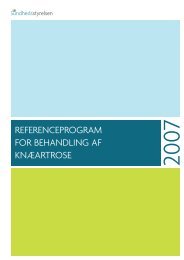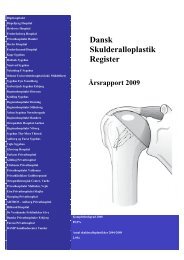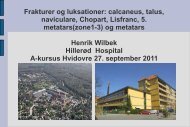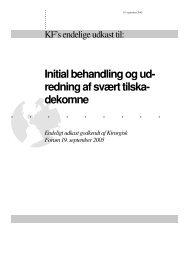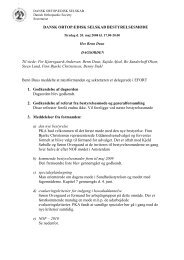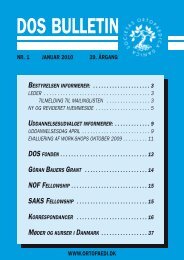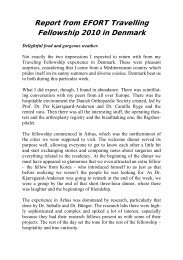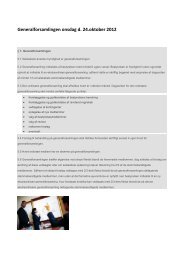DOS BULLETIN - Dansk Ortopædisk Selskab
DOS BULLETIN - Dansk Ortopædisk Selskab
DOS BULLETIN - Dansk Ortopædisk Selskab
You also want an ePaper? Increase the reach of your titles
YUMPU automatically turns print PDFs into web optimized ePapers that Google loves.
2010-378_<strong>DOS</strong> nr. 3 2010 29/09/10 10:08 Side 74<br />
Fast-track bilateral total knee arthroplasty<br />
Henrik Husted, Anders Troelsen, Kristian Stahl Otte,<br />
Billy B Kristensen, Gitte Holm, Henrik Kehlet<br />
Dep. of orthopedics & Dep. of anaesthesiology, Hvidovre University<br />
Hospital; Dep. of surgical pathophysiology, Rigshospitalet<br />
Background: Bilateral simultaneous total knee arthroplasty (BSTKA) is<br />
often found to be associated with increased morbidity and mortality.<br />
Fast-track surgery (ANORAK-HH) has reduced length of stay (LOS) for<br />
unilateral total knee arthroplasty, with high patient satisfaction and few<br />
readmissions.<br />
Purpose: Fast-track surgery may therefore also influence the potentially<br />
increased morbidity and mortality associated with the bilateral simultaneous<br />
procedure.<br />
Methods: Inclusion criteria were symptomatic bilateral arthritis and<br />
consent to BSTKA. Patients were not considered for the bilateral procedure<br />
if they had a history of or objective findings indicating cardiopulmonary<br />
disease. 150 patients (300 TKAs) were included, 87 were<br />
female. For comparison, a group of unilaterally TKA operated patients<br />
were found by registering data on the preceding and following patient<br />
matched for gender (but not for age) operated nearest on the index operation<br />
(BSTKA). Patients were subsequently excluded from comparative<br />
analysis if they were operated with TKA in the contra lateral knee (=<br />
staged bilateral TKA) during the study period. 271 patients thus registered<br />
as a control group, 160 were female. Patients were followed for a<br />
mean of 23.6 moths (SD 16.9) and a variety of parameters on outcome<br />
were analyzed and compared.<br />
Findings: Apart from staying longer (mean 4.7 days vs. 3.3 days) and<br />
using more blood transfusions (45.6% vs. 12.1%); the outcome at 3<br />
months and 2 years follow- up was identical or better in the bilateral<br />
group regarding morbidity (complications), mortality, satisfaction, range<br />
of motion, pain, use of walking aids, ability to return to work and ability<br />
to perform activities of daily living.<br />
Conclusion: Bilateral simultaneous total knee arthroplasty can be performed<br />
in selected patients in a fast-track set-up with results comparable<br />
to or better than unilateral total knee arthroplasty.<br />
74




